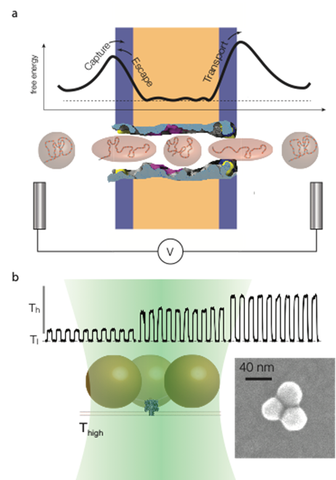Summary
Nanopores offer the potential to study a wide range of protein-related phenomena that includes unfolding kinetics, differences in unfolding pathways, protein structure stability and free energy profiles of DNA-protein and RNA-protein binding. In addition to providing a tool for fundamental protein characterization, nanopore measurement systems can also be used to study polymer confinement at the single molecule limit. We are developing new nanopore measurements that rapidly monitor the thermodynamic and kinetic limitations of these biosensors in order to interrogate their detailed molecular operation and provide a foundation for highly efficient biosensors that can be use in fundamental biophysics and biomedical applications.
Description

Fig. 1: (a) The free energy profile of a nanopore event contains several barriers to transport including capture, chemical interactions inside the pore and escape. (b) LSPR-nanopore devices provide a platform for rapid control over the environment through temperature pulses (shown), ramps, steps or sweeps.
We are developing new tools to investigate the energy landscape of single-molecule sensors. Our goal is to apply a wide-ranging array of technologies to probe the critical physicochemical properties of nanopore biosensors. These properties include the free energy of confinement for polymers as they partition into and interact with a nanopore (Fig. 1a), and the various roles of entropy and enthalpy governing their operation. Our measurements provide the fine detail needed to understand and manipulate the local environment in order to optimize molecular detection and characterization. We investigate the molecular details that regulate the capture efficiency (i.e., detection limit), retention time (i.e., signal-to-noise, and chemical selectivity), and transport. To achieve such these goals, we are developing interfaces that combine proteinaceous ion channels and local surface plasmon resonance (LSPR) objects such as gold nanoparticles (Fig. 1b) which enables precise temperature control with 100 MHz bandwidth or better at nanometer scales. We are using these measurements to study the dynamical properties of biomolecules, the application of LSPR particles as nanoscopic heating elements for precise control of temperature gradients on the nanosecond time scale, and ionic transport in confined environments. Together these tools provide a benchmark for optimization of single-molecule nanopore sensors.
Research Opportunities
- NRC/NIST Postdoctoral Fellowship
- 2-year fellowship
- Sponsored by the National Research Council
- Application requires an original research proposal
- Application deadlines: February 1 and August 1
- Stipend - $ 72,030/year; Travel Allotment - $3,000; Other benefits
- US citizenship required
- DNA Transport in Single Nanopores
- NIST NRC Postdoctoral Research Associateships Program
- Research Associateship Programs - National Academies of Sciences, Engineering and Medicine
Selected Publications
- Engineering Biological Nanopore Approaches toward Protein Sequencing, Wei, X., Penkauskas, T., Reiner, J. E., Kennard, C., Uline, M. J., Wang, Q., Li, S., Aksimentiev, A., Robertson, J. W. F., and Liu, C., ACS Nano acsnano.3c05628 (2023).
- Laser-based temperature control to study the roles of entropy and enthalpy in polymer-nanopore interactions, Angevine, C., Robertson, J. W., Dass, A., and Reiner, J. E., Science Advances 7, eabf5462 (2021).
- The Utility of Nanopore Technology for Protein and Peptide Sensing, J. W. F. Robertson and J. E. Reiner, Proteomics 18, 1800026 (2018).
- Single Molecule Nanopore Spectrometry for Peptide Detection, A. E. Chavis, K. T. Brady, G. A. Hatmaker, C. E. Angevine, N. Kothalawala, A. Dass, J. W. F. Robertson, and J. E. Reiner, ACS Sensors 2, 1319–1328 (2017).
- Theory of polymer-nanopore interactions refined using molecular dynamics simulations., A. Balijepalli, J. W. F. Robertson, J. E. Reiner, J. J. Kasianowicz, and R. W. Pastor, J. Am. Chem. Soc. 135, 7064–7072 (2013).
- Temperature Sculpting in Yoctoliter Volumes, J. E. Reiner, J. W. F. Robertson, D. L. Burden, L. K. Burden, A. Balijepalli, and J. J. Kasianowicz, J. Am. Chem. Soc. 135, 3087–3094 (2013).
- Theory for polymer analysis using nanopore-based single-molecule mass spectrometry., J. E. Reiner, J. J. Kasianowicz, B. J. Nablo, and J. W. F. Robertson, Proc. Natl. Acad. Sci. USA 107, 12080–12085 (2010).
- Structure of functional Staphylococcus aureus alpha-hemolysin channels in tethered bilayer lipid membranes., D. J. McGillivray, G. Valincius, F. Heinrich, J. W. F. Robertson, D. J. Vanderah, W. Febo-Ayala, I. Ignatjev, M. Losche, and J. J. Kasianowicz, Biophys. J. 96, 1547–1553 (2009).
- Single-molecule mass spectrometry in solution using a solitary nanopore, J. W. F. Robertson, C. G. Rodrigues, V. M. Stanford, K. A. Rubinson, O. V. Krasilnikov, and J. J. Kasianowicz, Proc. Natl. Acad. Sci. USA 104, 8207–8211 (2007).

